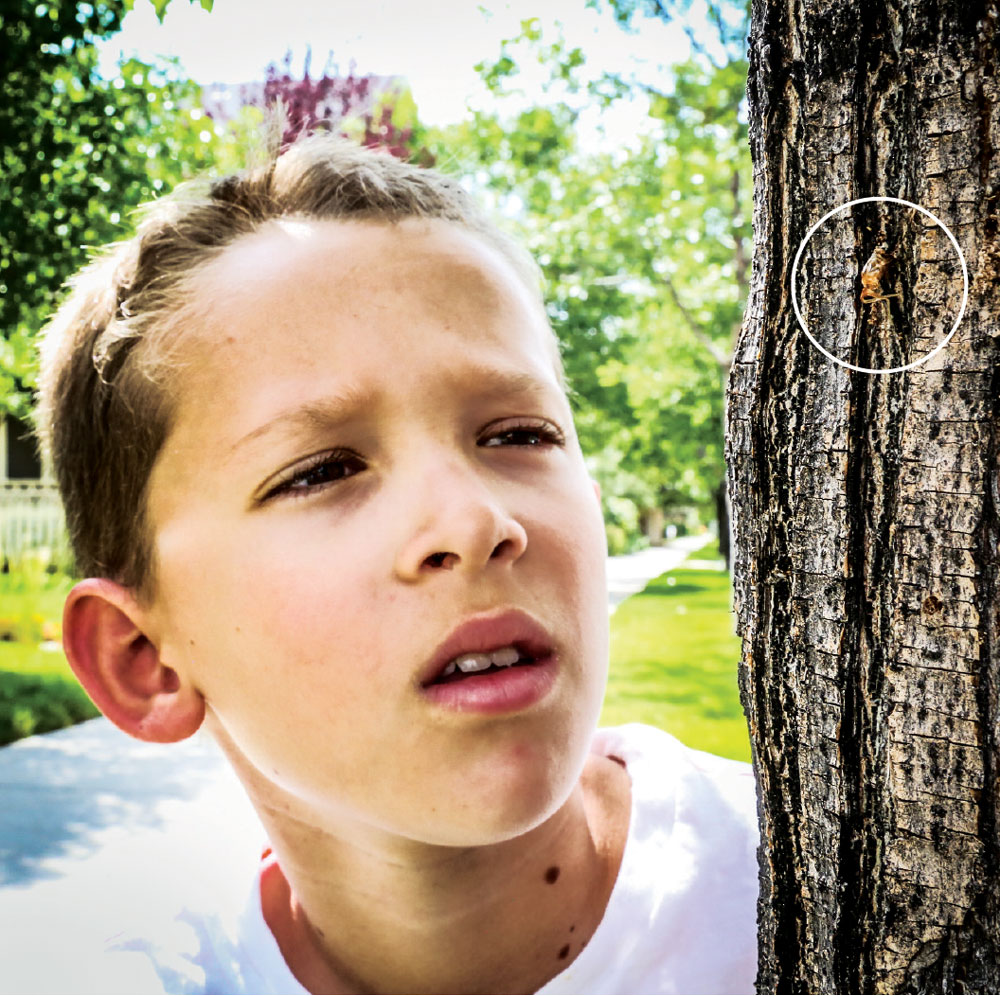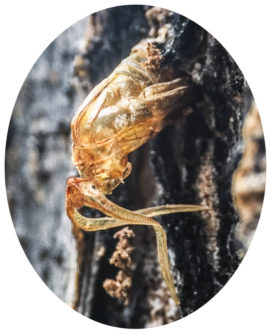
Theo Sam, 9, checks out the dried skin left in a tree by a lilac ash borer.
 Theo Sam, an inquisitive 9-year old, has many ideas and questions about the world around him. When he spotted holes in a tree near his mailbox, he puzzled over them briefly before beginning to investigate. In fact, that distinctive 1/4 inch round hole Sam observed was the exit hole of the lilac ash borer. The larvae tunnel through and feed on the ash tree before emerging and leaving their pupal skin.
Theo Sam, an inquisitive 9-year old, has many ideas and questions about the world around him. When he spotted holes in a tree near his mailbox, he puzzled over them briefly before beginning to investigate. In fact, that distinctive 1/4 inch round hole Sam observed was the exit hole of the lilac ash borer. The larvae tunnel through and feed on the ash tree before emerging and leaving their pupal skin.
Sara Davis, a forester with the City of Denver Parks and Recreation says that this insect differs from the more notorious emerald ash borer. “It’s a native pest, and there are controls,” she says. Davis notes that about 15% of Denver’s trees are ash trees, but that the city hasn’t allowed planting of ashes in over 10 years, since the emerald ash infestation first hit the Midwest. The lilac ash borer is common in Stapleton and Northeast Denver trees, however, which tend to be young (15-20 years old) and more susceptible to the pest. Infestation does not mean that a tree will die, and provided it is discovered early enough, professional treatment can save these trees. Older, more established trees can typically fight off the infestation.
The emerald ash borer, says Davis, is from Asia and is a far more destructive species. She points out that in Asia, its natural predators (a small breed of wasp) prevent the beetle from wreaking havoc on trees the way it has since finding its way to the U.S. in 2002. First found in Detroit, the Arbor Day Foundation estimates it has destroyed 40 million ash trees just in Michigan since then. Emerald ash borers leave tree bark looking like it is splitting, and you will typically see “wavy galleries where larvae have chewed thorough the bark,” according to Davis.
Though the emerald ash borer has been detected in Boulder County, it remains about 15 miles from Denver’s northern border at this time. Davis recommends that homeowners who love their trees hire a licensed tree care professional to determine if their trees need to be treated to prevent or cure these and other infestations. She reminds homeowners, too, that trees in the public right of way (“tree lawn”) are public property and the adjacent homeowner is responsible for care and maintenance of these trees. Removal of trees in the public right of way require a city permit.
“We live in an engineered forest,” says Davis, who talks about Denver’s trees as part of an ecosystem most residents probably take a little for granted. Davis, who holds degrees in environmental horticulture and urban forestry, says that urban foresters like herself “look at the whole of a city as a forest…the tree canopy is connected and creates corridors for people and wildlife.”
For Sam, the world around him is intriguing, but he shares that he is really more interested in “prehistoric underwater creatures….not dinosaur times but before; I like land creatures too…but underwater was one of the first places life evolved.” He hopes to become a paleontologist so he can study Colorado’s prehistoric life.
Questions About Trees?
Enter your property address in Denver’s tree inventory to learn what trees live on your public right of way: https://denverco.mytreekeeper.com/
If you have space in your public right of way, you can see if you are eligible for a free 15-gal. tree from the city: https://beasmartash.org/
The nonprofit organization The Park People offers low-cost trees: www.theparkpeople.org
Approved Street Tree List for Denver’s Public Right-of-Way: http://www.denvergov.org/content/dam/denvergov/Portals/747/documents/forestry/Street_tree_guide.pdf (Note: There is a column in the tree species list labeled “Water Quality Area.” Trees with an “x” in this column are trees that are good at improving water quality).
For general information on common diseases or pests contact the Denver County CSU Extension office: Colorado Master Gardener Help Line; envermg@ext.colostate.edu 720.913.5278


0 Comments